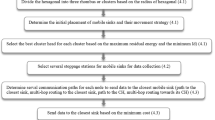Abstract
In wireless sensor networks (WSNs), sensor nodes near static sink will have more traffic load to forward and the network lifetime will get largely reduced. This problem is referred to as the hotspot problem. Recently, adopting sink mobility has been considered as a good strategy to overcome the hotspot problem. Despite its many advantages, due to the dynamic network topology caused by sink mobility, data transmission to the mobile sink is a challenging task. To achieve efficient data dissemination, nodes need to reconstruct their routes toward the latest location of the mobile sink, which weakens the energy conservation aim. In this paper, we proposed an energy-efficient cluster-based dynamic routes adjustment approach (EECDRA) which aims to minimize the routes reconstruction cost of the sensor nodes while maintaining nearly optimal routes to the latest location of the mobile sinks. The network is divided into several equal clusters and cluster heads are selected within each cluster. We also set some communication rules that manage routes reconstruction process accordingly requiring only a limited number of nodes to readjust their data delivery routes toward the mobile sinks. Simulation results show that the mobile sinks for reducing reconstruction of route have improved the energy efficiency and prolonged lifetime of wireless sensor network.








Similar content being viewed by others
References
Akyildiz IF, Su W, Sankarasubramaniam Y et al (2002) A survey on sensor networks. IEEE Commun Mag 40(8):102–114
Heinzelman W, Chandrakasan A, Balakrishnan H (2000) Energy-Efficient Communication Protocol for Wireless Micro sensor Networks. In: Proceedings of the Hawaii Conference on System Sciences
Lindsey S, Raghavendra CS (2001) PEGASIS: power efficient gathering in sensor information systems. Proc.Int’l Conf. Comm. (ICC ’01)
Liu Y, Xun-Xin, Rui-Hua Z (2011) An energy-efficient mobile sink routing algorithm for wireless sensor networks, in Wireless Communications, Networking and Mobile Computing (WiCOM), 2011 7th International Conference on, pp 1 –4
Nazir B, Hasbullah H (2011) Mobile Sink based Routing Protocol (MSRP) for Prolonging Network Lifetime in Clustered Wireless Sensor Network[C]// Computer Applications and Industrial Electronics (ICCAIE), 2010 International Conference on:624-629
Wang J, Yang X, Ma T et al (2012) An energy-efficient competitive clustering algorithm for wireless sensor networks using mobile sink. International Journal of Grid & Distributed Computing
Wang J, Yin Y, Zhang J et al (2013) Mobility based energy efficient and multi-sink algorithms for consumer home networks. IEEE Trans Consum Electron 59(1):77–84
Nuruzzaman MT, Ferng HW (2016) A low energy consumption routing protocol for mobile sensor networks with a path-constrained mobile sink, 2016 IEEE International Conference on Communications (ICC), Kuala Lumpur, pp 1–6
Xie G, Pan F (2016) Cluster-based routing for the mobile sink in wireless sensor networks with obstacles. IEEE Access 4:2019–2028
Wang J, Li B, Xia F et al (2014) An energy efficient distance-aware routing algorithm with multiple mobile sinks for wireless sensor networks. Sensors 14(8):15163–15181
Khan MI, Gansterer WN, Haring G (2013) Static vs. mobile sink: the influence of basic parameters on energy efficiency in wireless sensor networks. Comput Commun 36(9):965–978
Chen TS, Tsai HW, Chang YH et al (2013) Geographic convergecast using mobile sink in wireless sensor networks. Comput Commun 36(4):445–458
Khan AW, Abdullah AH, Razzaque MA et al (2015) VGDRA: a virtual grid-based dynamic routes adjustment scheme for mobile sink-based wireless sensor networks. IEEE Sens J 15(1):526–534
Kotsilieris TC, Karetsos GT (2013) Prolonging the lifetime of two-tiered wireless sensor networks with mobile relays. Isrn Sens Netw 7:1–7
Wang C, Shih J, Pan B et al (2014) A network lifetime enhancement method for sink relocation and its analysis in wireless sensor networks. Sens J IEEE 14(6):1932–1943
Zhang X, Bao H, Ye J et al (2013) A Data Gathering Scheme for WSN/WSAN Based on Partitioning Algorithm and Mobile Sinks[C]// IEEE, International Conference on High PERFORMANCE Computing and Communications & 2013 IEEE International Conference on Embedded and Ubiquitous Computing. IEEE:1968-1973
Liu X, Zhao H, Yang X et al (2013) SinkTrail: a proactive data reporting protocol for wireless sensor networks. IEEE Trans Comput 62(1):151–162
Xie S, Wang Y (2014) Construction of tree network with limited delivery latency in homogeneous wireless sensor networks. Wirel Pers Commun 78(1):231–246
Shen J, Tan H, Wang J, Wang J, Lee S (2015) A novel routing protocol providing good transmission reliability in underwater sensor networks. J Internet Technol 16(1):171–178
Zhang Y, Yu R, Xie S et al (2011) Home M2M networks: architectures, standards, and QoS improvement. IEEE Commun Mag 49(4):44–52
Liu H, Ning H, Zhang Y et al (2014) Role-dependent privacy preservation for secure v2g networks in the smart grid. IEEE Trans Inf Forensics Secur 9(2):208–220
Dong MX, Ota KR, Lin M (2014) UAV-assisted data gathering in wireless sensor networks. J Supercomput 70(3):1142–1155
Acknowledgements
This work was supported by the National Natural Science Foundation of China (61402234, 61672290) and Ministry of Science, ICT and Future Planning (KR) (IITP-2016-H8501-16-1014). Prof. Jong Hyuk Park is the corresponding author.
Author information
Authors and Affiliations
Corresponding author
Rights and permissions
About this article
Cite this article
Wang, J., Cao, J., Ji, S. et al. Energy-efficient cluster-based dynamic routes adjustment approach for wireless sensor networks with mobile sinks. J Supercomput 73, 3277–3290 (2017). https://doi.org/10.1007/s11227-016-1947-9
Published:
Issue Date:
DOI: https://doi.org/10.1007/s11227-016-1947-9




